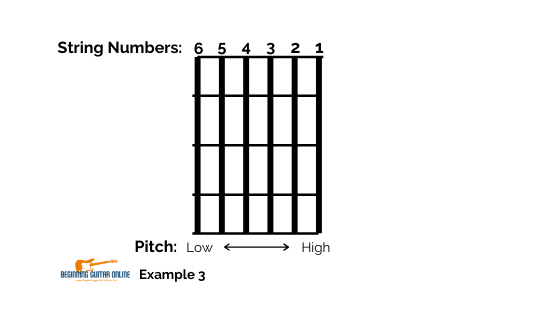Guitar String Names and Numbers
The strings names and numbers are interchange quite often when you’re having a conversation with other guitarists. One of the hardest things to do in the beginning is to memorize all of the note names and strings, but the work pays off really quickly. Not just in your conversations in your lessons, but with other musicians and in your playing too!
If you want to make a lot of progress really quickly when you’re just starting out, memorizing the string names and numbers is one of the most important things to do because it unlocks a lot of the musical shorthand when we start needing to speak to where to play things or the notes that are part of a chord.
Guitar String Numbers
In most examples or tuning explanations the strings will be referred to as “low to hight.” Counter intuitively the string names and numbers are based off of pitch and not the sightly line of the player. So when you’re looking down at your guitar strings the first string you see is the lowest string by the way it sounds.
Similarly you’ll hear some players or musicians you’re jamming with reference “the bottom” or the “top string.” Again this most often than not is referring to the low or high sound of the string and not the visual.
If you’re looking at the tuning pegs the lowest and highest strings are on either side of the neck (on a paddle style headstock). From the lowest string moving in a clockwise manner the string numbers are: 6-5-4-3-2-1. See Example 1.
For guitars with a blade-style headstock with the tuning pegs on top, the string numbers remain the same with the sixth string being closest to the base of the headstock and the nut of the guitar. These kinds of headstocks are often seen on electric guitars like Fender, Ibanez, ESP/Ltd, or many other brands. See Example 2.
For another type of blade headstock you’ll see the tuning machines on the bottom. This style reverses the order of the strings so the highest string, string one, is closest to the base of the headstock and the lowest string’s tuning peg will be the furthest away. This type of headstock is typically used for aesthetic reasons and won’t necessarily be used by a majority of guitar players.
No matter the type of headstock you have on your guitar the way the strings numbers are shown in music notation will be the same. Below you can see how the string numbers are shown on a chord chart. See Example 3.
Guitar String Names
Like we mentioned before, the names of the string names are based on the pitch they produce when plucked and not by the sightline of the player. Assuming you’re in standard tuning, the lowest and highest strings, strings 6 and 1, are both Es. Since they are the same pitch a couple octaves apart, you can differentiate the two by calling them the “low E” (sixth string) and the “high E” (first string).
From low to high, the string names on the guitar are: E-A-D-G-B-E. See Examples 4-6.
The easiest way to memorize the string names and numbers is to say them out loud as you play them. Over time, you’ll be exposed to the terminology enough times they’ll stick. Keep at it and you’ll have these down in no time!






